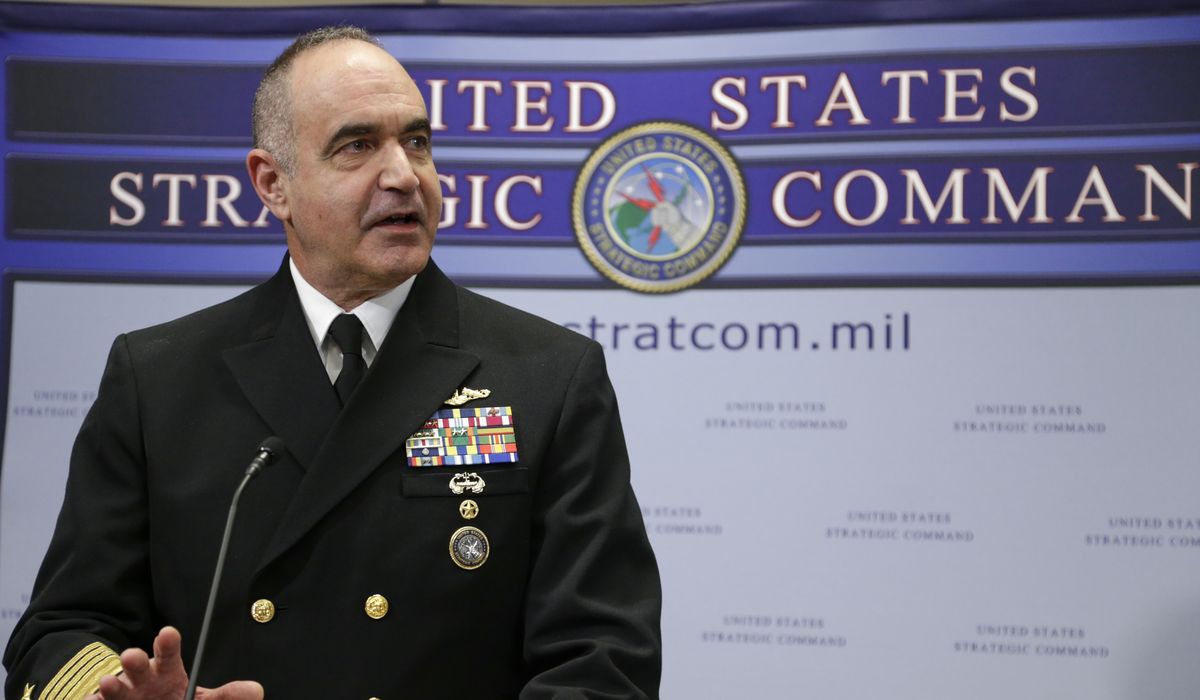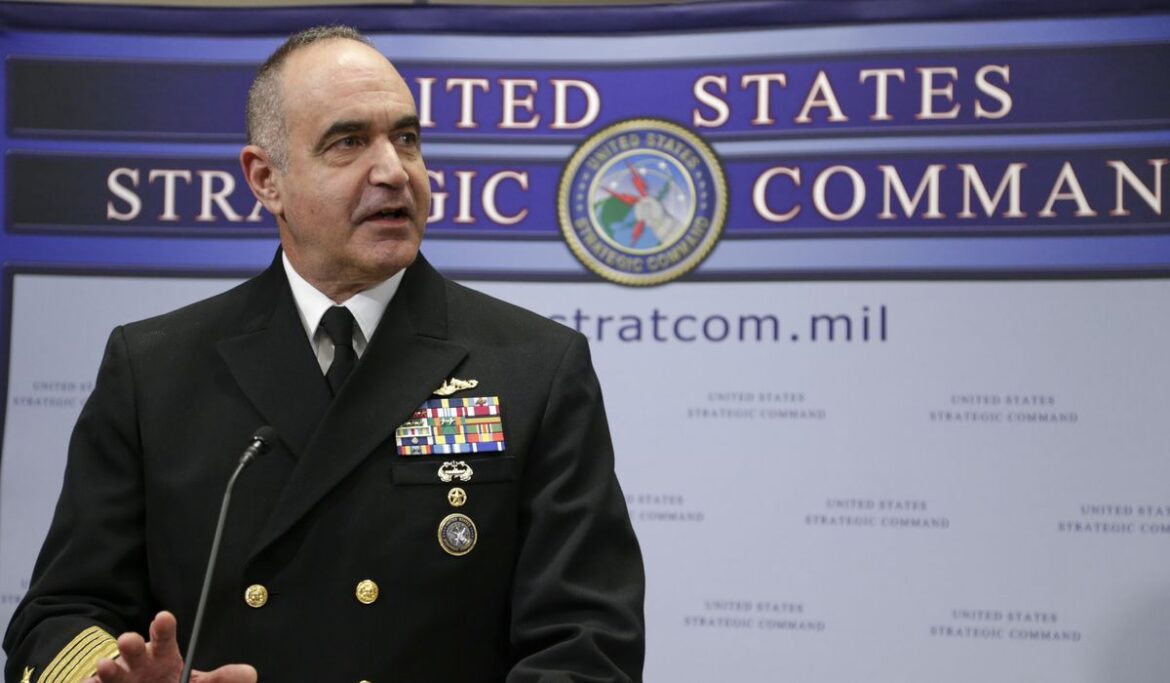
China is expanding its nuclear forces at a “breathtaking” pace, the commander of the U.S. Strategic Command warned in urging for strengthened U.S. nuclear deterrence against the danger.
Adm. Charles Richard, meeting with reporters at the command’s annual conference on deterrence Thursday, said it was still unclear how far and how fast China is preparing to go with its nuclear arsenal, but that the challenge posed by Beijing was real and growing.
“The threat posed to this nation, our allies from China is expanding at a breathtaking pace,” the admiral said. “We don’t know where that’s going to wind up.”
In May, Adm. Richard told the Senate Armed Services Committee that two years ago, “a great debate” was held on whether China would double its nuclear warheads by 2029. That doubling already has taken place, he told lawmakers, and further expansion is continuing.
The addition of 360 ICBM silos in western China is the “biggest and most visible” element of the buildup, along with the doubling of the number of road-mobile DF-31 missiles, he said. The People’s Liberation Army also has deployed a “true air leg” of its strategic forces with H-6N nuclear bombers armed with air-launched ballistic missiles.
Also, the Jin-class nuclear missile submarine force can launch attacks from protected “bastions” in the South China Sea and more missile submarines are being built.
SEE ALSO: Biden voices concern over China’s provocations on Taiwan in two-hour call with Xi
As the PLA builds a nuclear warning system, Chinese strategy is shifting from retaliatory strikes to “launch-on-warning,” Adm. Richard said. The readiness of Chinese nuclear forces also has been increased, and shorter-range nuclear missiles also have been deployed. Those missiles would not be needed “in a true minimum-deterrent, no-first-use policy” that China claims it has been pursuing, he said.
The test last year of a new polar-orbiting hypersonic missile provides Chinese nuclear forces with an unlimited range strike weapon that can launch nuclear attacks “from any azimuth… with great performance,” he said. “No nation in history has ever demonstrated that capability.”
Russia also is “in a similar category” as a nuclear threat to the U.S., “and then there’s North Korea, potentially others,” the four-star admiral said.
The shift from the decades-long U.S.-Russia bilateral standoff to a three- or four-way confrontation with nuclear powers is driving the U.S. modernization of nuclear forces.
U.S. defense officials say the likely weapon system for the new missile silos Beijing is building is the new DF-41 intercontinental ballistic missile, which can carry up to 10 multiple nuclear warheads. Intelligence estimates say China’s nuclear warhead stockpile, estimated to be around 250 warheads, will increase to as many as 1,000 warheads in the next eight years.
Adm. Richard has said the Biden administration’s highly anticipated policy review on nuclear forces, the Nuclear Posture Review, will be released by the Pentagon shortly. Defense sources said the unclassified posture review outlining the administration’s approach to nuclear weapons was to be released earlier this year, but was pulled back following the Russian invasion of Ukraine in February and the threats of nuclear attack made by President Vladimir Putin.
Adm. Richard said the Russian leader’s “thinly veiled nuclear saber-rattling” was unprecedented.
“I’m not sure we have ever had rhetoric like that in history,” he said. “I can’t remember an event in the Cold War even where you had that level of rhetoric, and I think it points to the reality of the threat that we face and the necessity for us in our allies, to not only take concrete steps with our deterrence forces, but to think through the theories on how we’re going to accomplish it.”
The U.S. government is also engaged in a major buildup of nuclear forces which have grown obsolete and in need of repair through years of neglect. Between 2021 and 2030, the Pentagon is expected to spend $634 billion on new weapons, missiles, submarines and bombers to modernize deterrent forces.
But the Biden administration has also announced publicly that it wants to reduce the role of nuclear weapons in U.S. security policy, taking up a policy set in motion during the Obama administration. That policy has been criticized by Republicans in Congress who say more needs to be done to strengthen deterrence when nuclear threats from China, Russia and North Korea are on the rise.
Adm. Richard said he “applauds and encourages” administration efforts to pursue arms control talks.
“All parties have got to comply, it has to be verifiable, but anything that limits the threat to us and our allies is a good thing,” Adm. Richard said. “And if done correctly it lowers the threat to everybody, it’s good for everyone that’s involved. That’s the advantage or benefit of joining into that.”
The State Department is leading efforts to hold arms talks, but negotiations with Moscow were cut off after the Ukraine invasion and China has refused to engage in strategic arms talks, despite its signing of the Non-Proliferation Treaty that calls on all signatories to reduce their arsenals through negotiations.
Adm. Richard said the military needs to regularly review the nuclear weapons and capabilities that will be needed for executing the strategy outlined in the nuclear posture review.
“I’m pretty confident that we’re going to go down that path inside the Department of Defense,” he said.
The four-star admiral said reports that Chinese telecommunications gear located near U.S. nuclear bases highlight the threat to command and control systems used for waging nuclear war, but added, “Our nation’s nuclear command and control has never been in a more resilient, reliable [or] robust alignment than it is today,” he said.
The Stratcom chief said that both inside and outside the Pentagon there is “this very flawed idea in my mind, that somehow nuclear sits in its own box off to the side, it has its own threat, you can decide how credible you want that threat to be: ‘Oh they would never do that.’”
“And somehow, there is this completely independent dial sitting over here where we can decide how much risk as a nation we wish to take in this area, and that is somehow disconnected from all the other things we do to defend this nation.”
He argued instead that all the security threats to the U.S., both nuclear and non-nuclear, are linked together and nuclear deterrence is the foundation for “every other thing we do inside the Department of Defense to defend the nation.”





